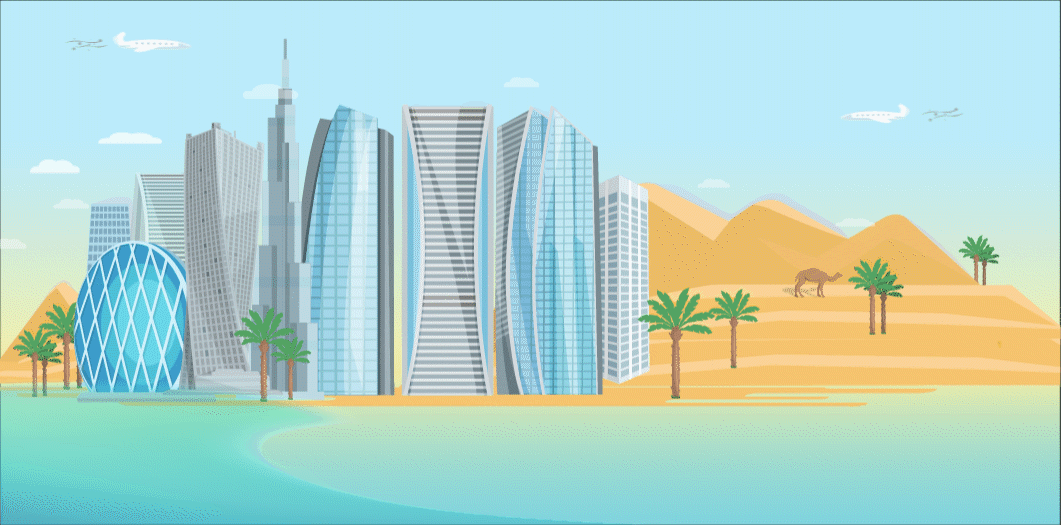
This article originally appeared on the Samuel Centre for Social Connectedness website.
A slew of emerging research papers linking air pollution with exacerbated COVID-19 symptoms has brought new attention to air quality. However, air pollution should be a major concern regardless of the pandemic. As the leading environmental risk factor worldwide, it kills around 4.2 million people per year. Thus, it is of greater priority to link COVID-19 best practices with longterm air quality solutions.
This is my fifth year in the UAE, and the recent months of staring at the same downtown Abu Dhabi view have led me to think more seriously about our air. The region has unique challenges. For one, it is mainly desert and subject to intense dust storms. In fact, dust and sea salt account for about half the population’s exposure to harmful PM2.5 particles. The UAE also has oil and gas fields, a heavy car-culture, and some of the busiest airports in the world.
Every July, our exposure to air pollution peaks due to heightened energy generation, frequent dust storms, and low rainfall levels. As I listen to the constant hum of my air conditioner and dehumidifier, I wonder, what can we learn from our pandemic lock-down to improve air quality?
1. Avoiding a second wave
Far too many cities have relaxed social distancing measures, only to experience a second wave of the pandemic. Similarly, air pollution has dipped for now, but it could peak again once residents take overdue holidays and factories make up for lost time.
This is our window to create long-lasting behavioural changes that protect our environment. As residents, we can opt for fuel and energy efficient vehicles and appliances, limit unnecessary travel, and utilize public transit. In tandem with these voluntary behavioural changes, we must also reimagine our urban planning to sustain this pandemic-induced dip in air pollution. A Dubai-based urban planner tells me, “raising the baseline, so that you cannot build an energy inefficient building, or you cannot build a completely car-centric development” is at the heart of sustainable planning. In fact, moving forward, “the more we can provide services for people within where they live, or where they work, so that they can walk or cycle there,” the better our air quality will be.
2. Robust monitoring
The UAE has demonstrated how COVID-19 testing can protect people. Similarly, Jill Engel-Cox, Director of the National Renewable Energy Laboratory’s Joint Institute for Strategic Energy Analysis, says that access to air quality measurements is critical for decision makers to understand the challenges and identify solutions. Additionally, “for people that are vulnerable or sensitive to air pollution, having that data and knowing that it’s a good time to be staying indoors” can drastically minimise their exposure.
The UAE is making major strides in air quality monitoring. Most notably, the Environment Agency – Abu Dhabi conducts an Air Emissions Inventory and shares real-time air quality information, as does the Dubai Municipality and nationally, the UAE Air Quality Index. These measurements are fundamental to understanding where pollution originates, who needs protection, and whether we are making progress towards cleaner air.
3. Rethinking indoor environments
On average, we spend 90 percent of our time indoors, and during COVID-19 this is closer to 99 percent. While we may feel safe from outdoor air pollution at home, Catriona Brady of the World Green Building Council explains that, “60 percent of our exposure to ambient air pollution actually happens when we’re inside.” In addition to pollutants entering from outside, indoor air quality is influenced by cooking stoves, cleaning chemicals, and mould buildup.
Strategically ventilating our homes can significantly limit our exposure. Additionally, Brady invites us to “plant a sensor” in a citizen-science campaign to deploy air quality sensors indoors.
4. Global cooperation
The rapid spread of COVID-19 has reminded us of how interconnected our world truly is. Ambient air in the UAE is impacted by domestic oil and petrochemical industries, as well as by industries and oil refineries in eastern Saudi Arabia and onshore oil ports in southern Iran. Similarly, dust storms can be exacerbated by drought in northern Iraq and the damming of rivers in Turkey.
Global challenges require global solutions. H.E. Razan Khalifa Al Mubarak, Managing Director of the Environment Agency – Abu Dhabi, emphasized to me that “we must consider what’s happening beyond country borders” when pursuing air quality indicators. Our winds take no notice of national jurisdictions, so we must work across them.
5. Protecting the vulnerable
Like COVID-19, air pollution disproportionately impacts those with pre-existing conditions and higher exposure. Children, elderly, asthmatic individuals and construction workers are among those most at-risk from air pollution in the UAE. Notifying vulnerable populations to remain indoors during dust storms, providing protective masks for outdoor work, and air proofing homes nearby pollution sources are some ways to mitigate air pollution exposure for our community.
At the same time, we must ensure that public health information reaches vulnerable groups. Funda Gacal, Senior Consultant of Air Pollution and Energy Policies at the Health and Environment Alliance (HEAL), notes that “we are mainly talking with mid- or high-income classes” when it comes to air quality. The multicultural and transient nature of the UAE population presents additional communication challenges. Streamlining air quality information to be as consistent, non-technical and multilingual as possible is key to safeguarding our communities.
Air pollution is likely to persist far beyond the pandemic. Implementing these lessons could save countless lives, lower emissions, and generate greater equality.

